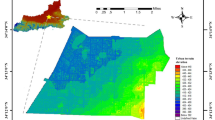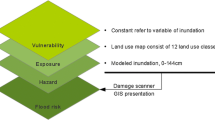Abstract
Flooding vulnerability assessment is an important issue in Taiwan since Taiwan lies within the most active tropical cyclone formation zone of the Western Pacific. Huge economic damages and losses of human lives are occurred almost every year. This study aims to evaluate flooding vulnerability of a given area subject to large-scale land developments. A scoring-based approach associated with a physiographic drainage-inundation model is developed to quantitatively evaluate vulnerability for flooding. The flooding vulnerability index defined as the product of an exposure score and a hazard score. The exposure score assesses relative losses exposed to flooding, which is determined by land-uses classification. The hazard score measures flooding severity, which is simultaneously determined by inundation depth and duration that are obtained from the inundation model for a design storm. The Yenshui River basin located in southwestern Taiwan is used an example to illustrate the proposed method. The results show that the projected urbanization plan within the Yenshui River basin would increase flooding vulnerability from 0.371 to 0.472. However, this value is reduced to 0.388 when the mitigation measure has been implemented. The obtained spatial distribution of flooding vulnerability for a design storm provides decision-makers useful information to identify hotspots of the study area and evaluate effects of flood-mitigation measure on flooding risk-reduction.








Similar content being viewed by others
References
Barroca B, Bernardara P, Mouchel JM, Hubert G (2006) Indicators for identification of urban flooding vulnerability. Nat Hazard Earth Syst Sci 6(4):553–561
Burton C, Cutter SL (2008) Levee failures and social vulnerability in the Sacramento-San Joaquin Delta Area, California. Nat Hazard Rev 9(3):136–149
Chen CN, Tsai CH, Tsai CT (2007) Reduction of discharge hydrograph and flood stage resulted from upstream detention ponds. Hydrol Processes 21(25):3492–3506
Chow VT, Maidment DR, Mays LW (1988) Applied Hydrology. McGraw-Hill, New York
Connor RF, Hiroki K (2005) Development of a method for assessing flood vulnerability. Water Sci Technol 51(5):61–67
Cunge JA (1975) Two dimensional modeling of flood plains. in Unsteady Flow in Open Channel, Vol. II, edited by Mahmood K. and Yevjevich V., Water Resources Publications, Fort Collins, Colorado
Cutter SL, Mitchell JT, Scott MS (2000) Revealing the vulnerability of people and places: a case study of Georgetown County, South Carolina. Ann Assoc Am Geogr 90(4):713–737
Cutter SL, Boruff BJ, Shirley WL (2003) Social vulnerability to environmental hazards. Soc Sci Q 84(2):242–261
Forte F, Strobl RO, Pennetta L (2006) A methodology using GIS, aerial photos and remote sensing for loss estimation and flood vulnerability analysis in the Supersano-Ruffano-Nociglia Graben, southern Italy. Environ Geol 50(4):581–594
Gao J, Nickum JE, Pan Y (2007) An assessment of flood hazard vulnerability in the Dongting Lake region of China. Lakes Reserv Res Manag 12(1):27–34
Green C (2004) The evaluation of vulnerability of flooding. Disaster Prev Manag 13(4):323–329
Hall J, Murphy C (2010) Vulnerability analysis of future public water supply under changing climate conditions: a case study of the Moy catchment, Western Ireland. Water Resour Manag 24(13):3527–3545
Hall JW, Sayers PB, Dawson RJ (2005) National-scale assessment of current and future flood risk in England and Wales. Nat Hazards 36(1–2):147–164
Hamouda MA, Nour El-Din MM, Moursy FY (2009) Vulnerability assessment of water resources systems in the Eastern Nile Basin. Water Resour Manag 23(13):2697–2725
Hashimoto T, Stedinger JR, Loucks DP (1982) Reliability, resiliency and vulnerability criteria for water resources systems performance evaluation. Water Resour Res 18(1):14–20
Huang Y, Zou Y, Huang G, Maqsood I, Chakma A (2005) Flood vulnerability to climate change through hydrological modeling: a case study of the Swift Current Creek watershed in western Canada. Water Int 30(1):31–39
Jonkman SN, Kok M, Vrijling JK (2008) Flood risk assessment in the Netherlands: a case study for dike rink South Holland. Risk Anal 28(5):1357–1373
Lugeri N, Kundzewicz ZW, Genovese E, Hochrainer S, Radziejewski M (2010) River flood risk and adaptation in Europe − assessment of the present status. Mitig Adapt Strat Glob Chang 15(7):621–639
Meyer V, Scheuer S, Haase D (2009) A multicriteria approach for flood risk mapping exemplified at the Mulde river, Germany. Nat Hazards 48(1):17–39
Odeh D (2002) Natural hazard vulnerability assessment for statewide mitigation planning in Rhode Island. Nat Hazard Rev 4(3):177–187
Pandey RP, Pandey A, Galkate RV, Byun HR, Mal BC (2010) Integrating hydro-meteorological and physiographic factors for assessment of vulnerability to drought. Water Resour Manag 24(5):4199–4217
Simonovic SP, Li H (2003) Methodology for assessment of climate change impacts on large-scale flood protection system. J of Water Resour Plan Manag 129(5):361–371
Simpson DM, Human RJ (2008) Large-scale vulnerability assessments for natural hazards. Nat Hazard 47(2):143–155
The Sixth River Management Office (TSRMO) (1998) Regulation Planning for the Yenshui River. The Sixth River Management Office, Kaohsiung, Taiwan. (in Chinese)
Tingsanchali T, Karim MF (2005) Flood hazard and risk analysis in the southwest region of Bangladesh. Hydrol Process 19(10):2055–2069
Tingsanchali T, Karim F (2010) Flood-hazard assessment and risk-based zoning of a tropical flood plain: case study of the Yom River, Thailand. Hydrol Sci J 55(2):145–161
Tran P, Shaw R, Chantry G, Norton J (2009) GIS and local knowledge in disaster management: a case study of flood risk mapping in Viet Nam. Disasters 33(1):152–169
Wu CC, Kuo TH (1999) Typhoons affecting Taiwan: current understanding and future challenges. Bull Am Meteorol Soc 80(1):67–80
Acknowledgements
This work was supported by the “Landmark Program of NCKU Top University Project” of National Cheng Kung University, Taiwan, ROC (Project No. R-046). The authors acknowledge the Editor and two anonymous reviewers for their helpful comments.
Author information
Authors and Affiliations
Corresponding author
Rights and permissions
About this article
Cite this article
Shiau, JT., Chen, CN. & Tsai, CT. Physiographic Drainage-Inundation Model Based Flooding Vulnerability Assessment. Water Resour Manage 26, 1307–1323 (2012). https://doi.org/10.1007/s11269-011-9960-5
Received:
Accepted:
Published:
Issue Date:
DOI: https://doi.org/10.1007/s11269-011-9960-5




